Monmouthshire Reformatory for Boys, Pontypool, Monmouthshire, Wales
The Monmouthshire Reformatory School for Boys was certified for operation February 7th, 1859. Its was located at Little Mill, in the parish of Mamhilad, near Pontypool, at the end of what is now Ty-Draw Lane. The premises, an old farm, could accommodate initially 20 boys and its arrangements, according to an early inspection report, were "of the simplest and cheapest form". The school instruction was carried out by Mr S.C. Baker, the honorary chaplain.
By the end of 1859, just five boys had been admitted, the number rising to six by the following summer. Apparently the number of juvenile offenders in the county had fallen off steeply in the past two or three years. At the end of 1863, there were only five inmates, making the net cost per head unusually high at over £23 a year. The school's inspector suggested that the school might be merged with the Glamorgan Reformatory.
The School had 14 acres of land which was cultivated by the boys, with cows and pigs also being kept. By 1864, Samuel and Mary Arnold were the superintendent and matron of the establishment. They were assisted by a labourer, with a schoolmaster now attending each day from a neighbouring parish. Although Mr Arnold was commended by the inspector as being trustworthy, well meaning, and an excellent farm manager, he was judged as not having sufficient ability or education for the post of superintendent.
In 1867, the cottage adjoining the farmhouse was fitted up for the accommodation of the boys, providing a small additional dormitory above, and a store room and committee room below. The barn was burnt down in the spring of that year, probably by one of the boys although nothing could be proved.
By 1870, the average number of inmates had risen to 18, with the net cost of their maintenance (taking farm income into account) now just under £10 a year. An inspection report recommended that the buildings needed enlarging and improving as there was just one room had to serve as both a school room and dining room. Various alterations and improvements were subsequently carried out. It was noted that the schooling took place before breakfast and after supper. In 1873, the schoolmaster was recorded as being Mr C. Merrick.
In 1880, the average number of boys in residence was 33. The School sent a large quantity of vegetables to market. Physical punishment was rare and a system of fines and bad marks was used to help maintain discipline. Each boy in his first year received 1½d. a week, 2d. in the second year, and 2½d. in the third. The money was held in credit and paid to each boy on his discharge. Of the 18 boys discharged in 1877-79, 14 were doing well, three had been convicted of crime, and one was dead.
The School site is shown on the 1882 map below.
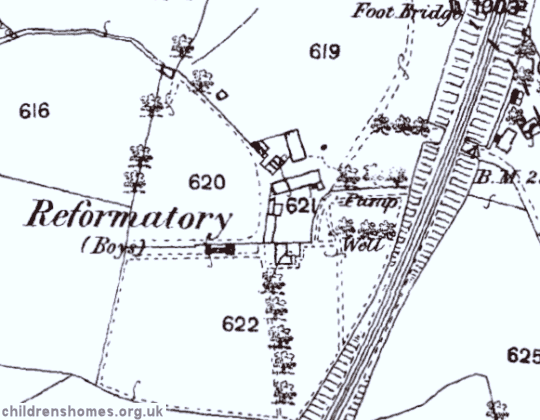
Monmouthshire Reformatory for Boys site, c.1882.
In 1881-2, a new kitchen, dormitory and school-room were erected. The farmland was steadily increased, first to 24 acres and then to 40 acres. The Arnolds' son, William, was now assisting in the running of the institution. In 1884, part of the premises were fitted up as an infirmary, and in 1886 the schoolmaster's accommodation was enlarged.
In September, 1888, after a quarter of a century as superintendent and matron, the Arnolds were succeeded by Mr Edwin Bilcliffe and his wife. The other staff at this date were the schoolmaster, Mr C. Merrick (or Meyrick); labour master, Mr Jones; and a domestic servant.
In 1897 it was noted that there were weekly visit by a county council lecturer, giving instruction on agriculture and horticulture, and by a drill sergeant who trained the boys in extension motions. A cricket and football field were laid out, there were occasional magic lantern lectures, and a Christmas entertainment was held. The following year, a new greenhouse was erected measuring 50 feet by 12 feet. In 1900, a new dormitory was constructed, 37½ feet by 17½ feet, with a drying room underneath.
The School site is shown on the 1901 map below.
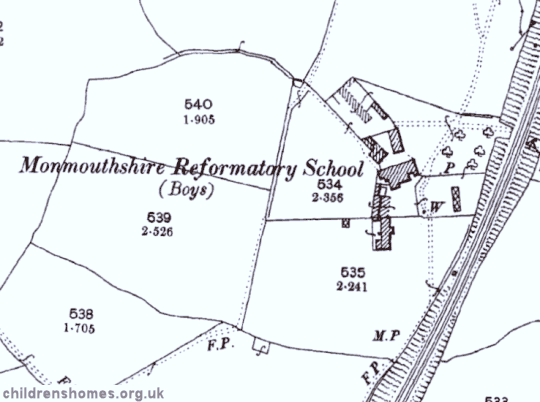
Monmouthshire Reformatory for Boys site, c.1901.
Following Mrs Bilcliffe's death at the end of 1904, Mr and Mrs W.C. Pobgee took over as superintendent and matron, with Miss M. Driver as assistant matron. In September, 1906, the long-serving schoolmaster, Mr Merrick died from meningitis. The industrial training now included drawing, and carpentry was introduced. Physical training included twice-weekly sessions of slow movements with heavy dumb-bells. Singing by ear was being taught. On July 2nd, 1906, the official capacity of the School was increased to 40 places. By 1907, an open-air swimming pond had been constructed.
Mr Pobgee died on January 23rd, 1908, and Mrs Pobgee left on March 3rd. Mr Pobgee succeeded Mr Pobgee on March 1st but left on March 12th. Mr and Mrs F.E. Craven Jones took charge on April 9th. The schoolmistress, Miss L. Forgan left on December 31st, 1907, and was replaced by Mr G.W. Nodding on January 1st. He left on February 4th and was succeeded by Mr S.H. Smith who left on May 5th and was replaced by Mr R. Jones.
Following the construction of a new dormitory, new superintendent's office, officers' sitting room, and enlargement of the playground, the school's capacity was further increased to 55 places on June 1st, 1910. In the same year, a brass band was started. In 1911, there were further alterations and additions to the buildings and a new water-supply scheme was under consideration. The boys had now been provided with night-shirts and the band boys with overcoats. On December 15th, 1916, the School was certified to accommodate up to 63 boys.
The School site is shown on the 1920 map below.
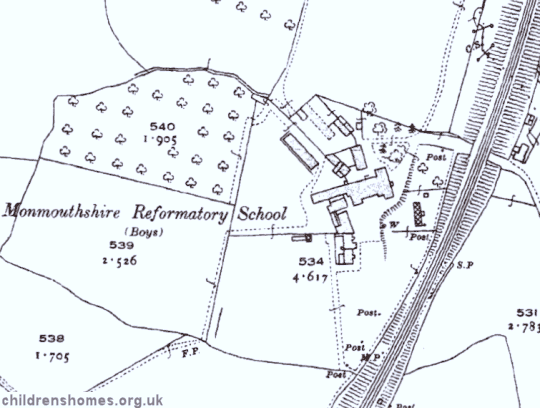
Monmouthshire Reformatory for Boys site, c.1920.
Despite its expansion in recent years, the School was closed on March 2nd, 1922.
The surviving buildings, now known as Ty-Draw, have been converted to residential use.
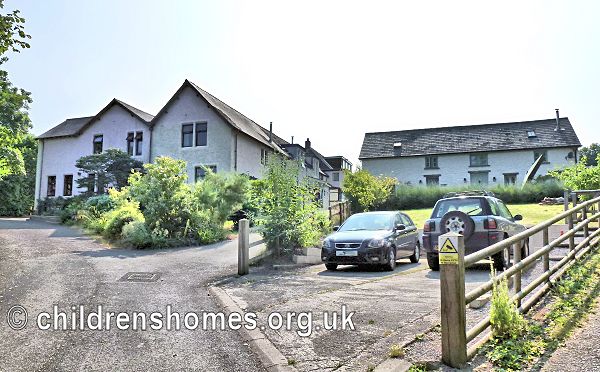
Former Monmouthshire Reformatory for Boys from the north-east, 2013. © Peter Higginbotham
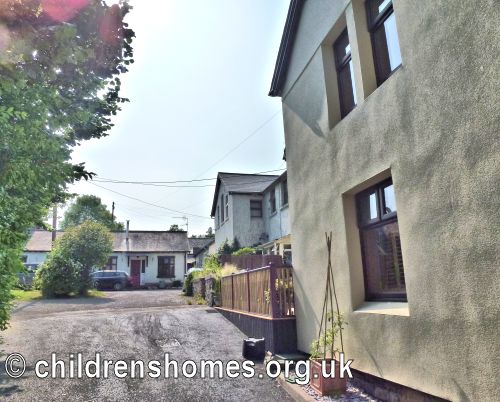
Former Monmouthshire Reformatory for Boys main building from the east, 2013. © Peter Higginbotham
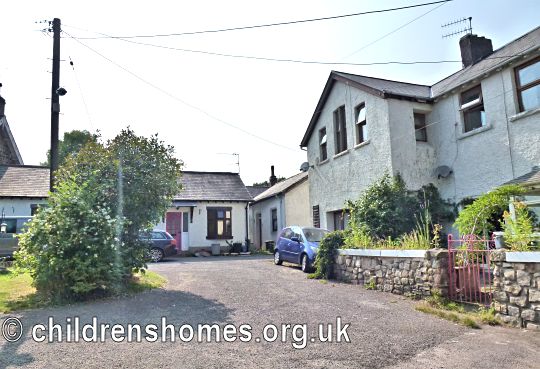
Former Monmouthshire Reformatory for Boys main building from the east, 2013. © Peter Higginbotham

Former Monmouthshire Reformatory for Boys southern building from the north-east, 2013. © Peter Higginbotham
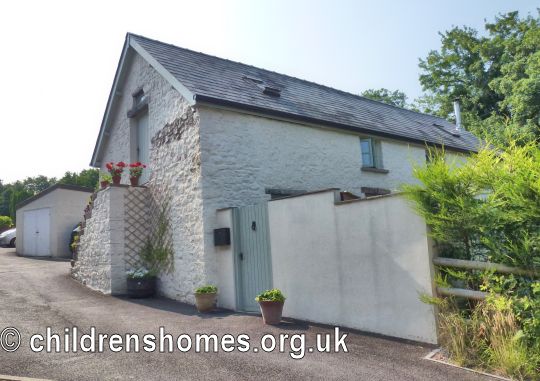
Former Monmouthshire Reformatory for Boys dormitory(?) block from the south-east, 2013. © Peter Higginbotham
Records
Note: many repositories impose a closure period of up to 100 years for records identifying individuals. Before travelling a long distance, always check that the records you want to consult will be available.
- Gwent Archives, Steelworks Road, Ebbw Vale NP23 6DN. Holdings, in Quarter Sessions records, comprise: Director's minutes books (1859-1923); Draft minute book (1908-23); Director's visiting books (1859-1922); Visitor's book (1859-1922); Register of boys (1859-1914); Register of admissions and discharges (1872-1922); Incidental returns (1912-1921).
Census
Bibliography
- Carpenter, Mary Reformatory Schools, for the Children of the Perishing and Dangerous Classes, and for Juvenile Offenders (1851, General Books; various reprints available)
- Carlebach, Julius Caring for Children in Trouble (1970, Routledge & Kegan Paul)
- Higginbotham, Peter Children's Homes: A History of Institutional Care for Britain's Young (2017, Pen & Sword)
- Abel Smith, Doroth Crouchfield: A History of the Herts Training School 1857-1982 (2008, Able Publishing)
- Garnett, Emmeline Juvenile offenders in Victorian Lancashire: W J Garnnett and the Bleasdale Reformatory (2008, Regional Heritage Centre, Lancaster University)
- Hicks, J.D. The Yorkshire Catholic Reformatory, Market Weighton (1996, East Yorkshire Local History Society)
- Slocombe, Ivor Wiltshire Reformatory for Boys, Warminster, 1856-1924 (2005, Hobnob Press)
- Duckworth, J.S. The Hardwicke Reformatory School, Gloucestershire (in Transactions of the Bristol and Gloucestershire Archaeological Society, 1995, Vol. 113, 151-165)
Links
- Red Lodge Museum, Bristol — a former girls' reformatory.
Except where indicated, this page () © Peter Higginbotham. Contents may not be reproduced without permission.


